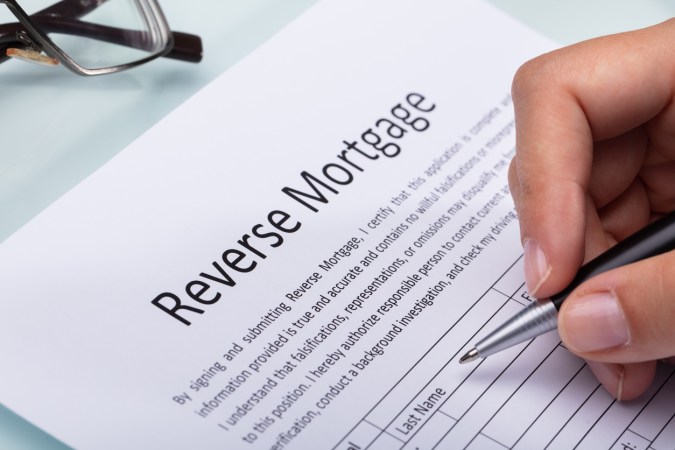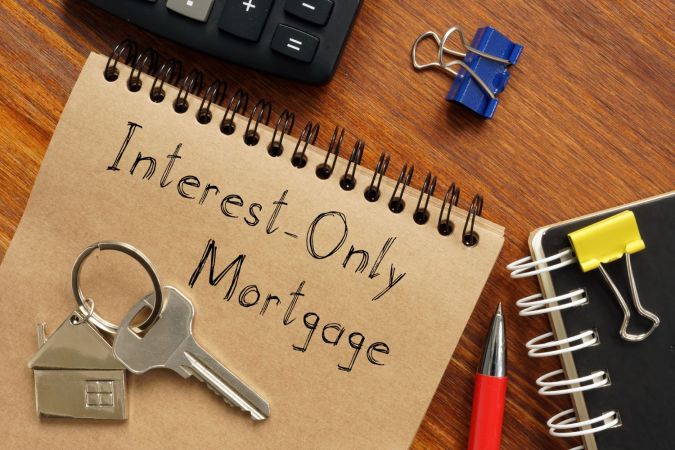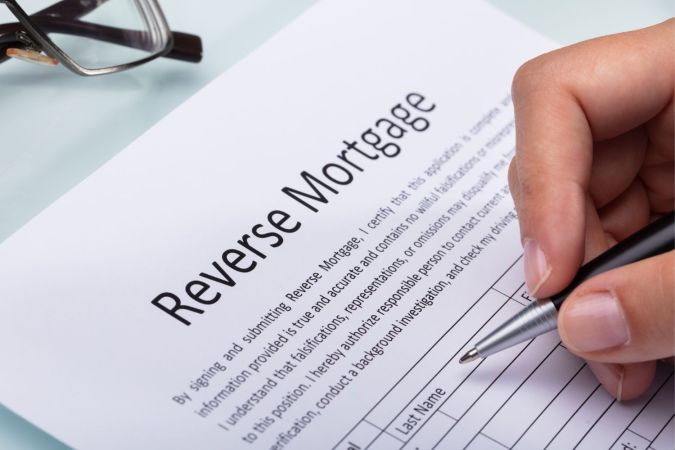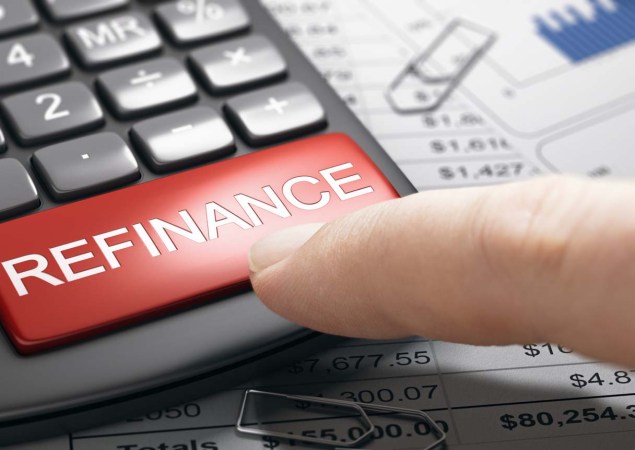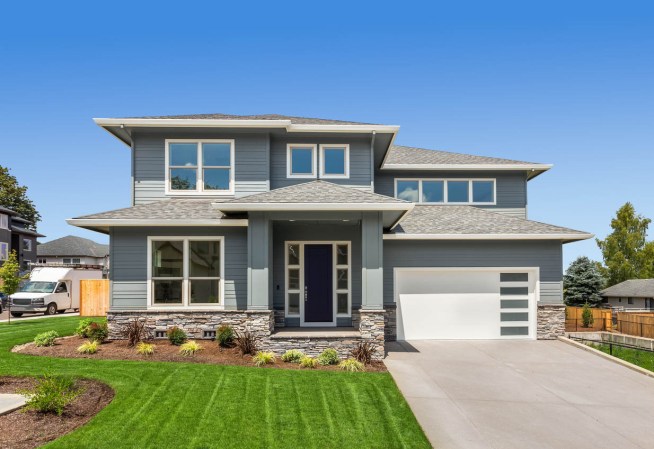We may earn revenue from the products available on this page and participate in affiliate programs. Learn More ›
Q: My partner and I want to renovate our kitchen in the coming months, but we’re not sure how to pay for it. We were told a second mortgage might work since we have a lot of equity in our home. What is a second mortgage, and how does it work?
A: Many homeowners wonder “What is a second mortgage?” when they want to renovate their homes. They may have heard about it from friends or family, or their bank recommended taking out another mortgage to get extra funds. Taking out another mortgage can seem intimidating, but a second mortgage is a common way for homeowners to get equity out of their home.
Before getting a second mortgage, homeowners will want to have a good understanding of their options for accessing home equity. In addition to considering loan length and interest rate, homeowners may want to use a second-mortgage calculator to fully understand the cost and benefits of a new loan. Homeowners wondering how to get a second mortgage can learn more about this type of loan and determine if it will meet their financial needs.
A second mortgage, also called a junior-lien, is a type of loan that allows the homeowner to tap into their home’s equity.
How does a second mortgage work? Also known as a junior-lien, a second mortgage is a loan homeowners can use to access the equity in their homes. Homeowners can use this equity as extra cash to fund a variety of needs, from debt repayment to home renovations. To tap into their equity, homeowners use the value of their home as collateral to take out a second loan on the house.
The reason this type of loan is called a second mortgage is because of the order in which debts get paid if the homeowner has to sell the home to cover their debt—or if the lender forecloses on the home. The homeowner or lender will use the sale proceeds to pay off the original mortgage used to buy the home first, then the second mortgage. If the home doesn’t have enough value to pay for both loans, the second-mortgage lender may not get the full amount back, which makes it a riskier loan type.
For example, a homeowner may have two mortgages and owe $200,000 on the first and $100,000 on the second. Eventually, they can no longer make their payments and the home sells for $250,000. The lender of the second mortgage may only receive $50,000 of the total $100,000 owed because the sale proceeds go toward the original mortgage first.
The two main types of second mortgage are home equity loans and home equity lines of credit (HELOC).
There are two main types of second mortgages: a home equity loan and a home equity line of credit (HELOC). Both types of second mortgage let homeowners use their homes as collateral to get funds from their equity. Homeowners can typically get either type of home equity financing through one of the best mortgage lenders or banks in their area.
However, home equity loans and HELOCs differ from one another. Home equity loans are more like traditional mortgages, where the borrower pays a set amount each month for an agreed-upon period of time, or term. A HELOC, on the other hand, is a revolving credit line that’s similar to a credit card. Homeowners can get approval for a HELOC with a certain limit and then borrow up to that limit and pay it back as many times as they like until the loan term is complete.
A home equity loan provides a lump sum of cash from the homeowner’s equity in exchange for a second lien on the property.
When most people talk about a second mortgage, they are referring to a home equity loan, since it is a common way for homeowners to get the equity out of their homes in one large payment. This type of loan is very similar to the first mortgage on a house. This type of loan is very similar to the first mortgage on a house in that a homeowner offers their home as collateral in exchange for funds from a mortgage lender. The exact amount of money available depends on a few factors related to the borrower and the property.
Homeowners usually have to meet credit score and income requirements to get a second loan. Lenders often ask homeowners to provide pay stubs and other financial documents showing their income. Homeowners may also have to show their current debt-to-income ratio, which is calculated by dividing their monthly debt payments by their gross monthly income. This helps the lender determine if the borrower has enough cash flow each month to pay for the second loan.
The homeowner may also wonder what the second home mortgage requirements are in order for them to qualify for a second-mortgage loan. Generally, homes have to appraise at a certain value to qualify for a home equity loan, because the appraisal affects the homeowner’s equity. For example, if a homeowner owes $200,000 on their first mortgage and wants to take out a second, but the home only appraises for $210,000, the owner may not qualify for a home equity loan. With only $10,000 in equity in the home, the cost and risk of a home equity loan may not make sense for the homeowner or the lender.

A HELOC works similarly to a credit card but usually has a lower interest rate.
A HELOC is another type of second mortgage that uses a home’s equity to provide funds to the homeowner. Unlike a home equity loan, a HELOC is a type of revolving credit. This means it works more like a credit card that’s secured by the homeowner’s property. Instead of approving a lump sum, the mortgage lender approves a credit limit for the line of credit. Homeowners can borrow against the HELOC account as much as they like, up to the credit limit. If the homeowner pays back the money they’ve borrowed—plus interest—they can borrow up to the credit limit again.
HELOCs aren’t unlimited sources of home equity funds for homeowners, however. As with a home equity loan, borrowers usually have to meet income and credit requirements in order to qualify. Additionally, HELOCs have specified periods when homeowners can access their line of credit, known as draw periods, and homeowners may only use the funds in their HELOC during this time. Many HELOCs start with an initial draw period, such as for the first 10 years after approval. Once the draw period is up, the borrower can’t take any more money from the HELOC and must pay it back in full, including any accrued interest.
Because HELOCs are not traditional loans, homeowners only have to pay back what they borrow. This means a homeowner could get a HELOC with a credit limit of $50,000 and only borrow $20,000 during the draw period. The homeowner will then only have to pay back the $20,000 borrowed plus any interest or fees, rather than the full $50,000 they were approved to borrow.
Home equity loans generally have fixed interest rates, while HELOCs have variable interest rates.
The delivery of funds isn’t the only difference between a home equity loan and a HELOC. Most of the time, the best home equity loans have a fixed interest rate. This means homeowners pay a fixed monthly payment—much like their first mortgage. HELOCs, on the other hand, typically have variable interest rates.
If a homeowner chooses a home equity loan, their mortgage lender will offer them a set interest rate. They’ll also choose the length of their second mortgage, which is the period in which they will repay the lender using a predictable monthly payment. Having a set payment each month can make it easier for homeowners to budget their monthly income.
A variable interest rate with a HELOC, however, can fluctuate over time. Lenders use what’s known as the prime market rate to determine the current interest rate for HELOCs. The prime rate is calculated by individual banks or lenders. It’s the baseline rate financial institutions use to set their rates for loans and lines of credit. Many banks use data from the Federal Reserve to set their prime rate. To account for changing interest rates, many lenders offer an initial fixed rate for HELOC borrowers. For example, a lender might fix HELOC interest rates at 5 percent for the first 5 years of the draw period. After the initial 5-year fixed rate, the HELOC’s rate could go up or down depending on the current prime rate.
A third, and less common, type of loan is a soft second mortgage, which buyers can use to cover the costs of purchasing a primary home.
A less common type of loan, a soft second mortgage (also called a silent second mortgage) refers to a loan that home buyers take out to cover the costs of purchasing a home. The most common reason for using a soft second mortgage is to cover a larger down payment on a home. Often, silent second mortgages are backed by the federal government as a way to help people without substantial savings get on the property ladder. One such example is the United States Department of Housing and Urban Development’s (HUD) Good Neighbor Next Door (GNND) program, which is designed to help eligible teachers and emergency responders purchase a home at a discounted price.
A soft second mortgage may also be funded by a private lender. In this case, borrowers must inform their main mortgage provider of the loan. Failure to do so is considered a form of mortgage fraud. If the main lender finds out that the borrower has a soft second mortgage that they didn’t disclose, the borrower may lose their home or may face prosecution.

Homeowners can use a second mortgage to access their home equity if they don’t want to refinance their primary mortgage.
A home mortgage refinance is the process of taking out an entirely new loan to pay off a homeowner’s existing mortgage. Homeowners generally choose to refinance so they can take advantage of better mortgage terms, such as a lower interest rate. Many homeowners find that they can lower their monthly mortgage payment by refinancing. Some homeowners even use a cash-out refinance to get a new mortgage and access the equity in their home by getting a lump-sum payment when they close on the refinance.
If rates are high or a refinance isn’t favorable, however, homeowners might consider a second mortgage instead of a refinance. Using a second mortgage lets them use home equity funds without losing favorable terms from their first mortgage. Home equity loans and HELOCs can also be a better choice than refinancing for homeowners if their primary mortgage is almost paid off.
For example, a homeowner might have a low interest rate for their primary mortgage. Current rates may be higher than their original rate, meaning that refinancing their home could cost them more over time than continuing to pay off the mortgage at the current rate. By taking out a second mortgage, they can access part of their equity while maintaining their low monthly payment on the primary mortgage. They’ll likely pay a higher interest rate for the second mortgage, but they would likely pay less in interest in the long run than they would if they refinanced at a higher rate. Homeowners can search “second mortgage vs. refinance” to learn more about the difference between these two types of loans.
Taking out a second mortgage can mean the homeowner will make two mortgage payments each month.
An important point for homeowners to remember when researching second mortgage options is the reality of a second mortgage payment each month. Most homeowners who take out a second mortgage have to make a second payment in addition to their primary mortgage payment. This is especially true if the homeowner takes out a home equity loan, where payments are fixed for the length of the loan.
Homeowners who want to take out a second mortgage will want to carefully consider their financial situation, which will help them decide if getting another mortgage is affordable. Some homeowners may find that the second payment each month puts too much of a strain on their budget. Too much stress on a homeowner’s budget could lead to missed payments or an inability to pay other bills, such as car loans or health insurance.
It’s recommended that homeowners understand the cost of a second mortgage before jumping into one. For example, they might request a breakdown of the estimated monthly cost of their new mortgage from their mortgage lender. Homeowners can then compare their existing monthly costs with the expense of the new second mortgage. Comparing current expenses to potential costs can help homeowners stay realistic about their ability to afford a second mortgage.
The homeowner is typically limited in how much equity they can borrow against.
Mortgage lenders don’t typically let homeowners borrow against the full equity they have in their homes. Instead, they use a combined loan-to-value (CLTV) ratio limit to determine how much equity a homeowner can borrow against. The CLTV ratio is how much a homeowner wants to borrow divided by the value of their home. The combined ratio includes the remaining balance on a homeowner’s primary mortgage and their proposed balance on a second mortgage. The exact amount varies by lender, but it’s common for lenders to limit borrowing to 85 percent or less of the homeowner’s equity.
For example, a homeowner may owe $200,000 on a home worth $500,000, which means they have $300,000 in home equity. Their lender, however, may have a CLTV ratio limit of 80 percent. In this case, the homeowner won’t be able to take out a home equity loan or HELOC for the full $300,000 they have in equity. This means they can borrow up to $240,000—or 80 percent—of their home equity.
This also means homeowners will want to have significant equity built up in their home before applying for a second mortgage. For the homeowner, the cost of taking out a small second mortgage may not be worth the risk of losing their home or the cost of making a second monthly payment.

Lenders usually have strict qualification requirements for second mortgages, such as a 620 minimum credit score and a debt-to-income (DTI) ratio of no more than 43 percent.
For many homeowners, the process of getting a second mortgage is much like the process to get their first mortgage. Shopping for a second mortgage, however, doesn’t usually include the stress of shopping for a new house as well. The exception is when a homeowner wants to buy a new house before their original home sells. They can use a second mortgage and use the equity in their existing home to buy their next one. Then they pay off the second mortgage when the first home sells.
To qualify for a second mortgage, homeowners will need to meet strict requirements from their mortgage lender. For example, most mortgage lenders require a minimum credit score of 620. Homeowners who are looking to take out a larger second mortgage may have to meet even more stringent credit requirements.
Lenders also look at a homeowner’s debt-to-income (DTI) ratio. A DTI ratio tells a lender how much debt a homeowner is carrying compared to how much money they make. Lenders calculate the DTI ratio by dividing an applicant’s monthly debt obligations by their monthly income. For example, a homeowner who makes $5,000 in monthly income and owes $1,500 in monthly debt payments has a DTI ratio of 30 percent. Typically, lenders like to see DTI ratios below 43 percent for a second mortgage.
The interest rate on a second mortgage is generally higher than the interest rate on a primary mortgage.
Second-mortgage lenders generally take a bigger risk by being the second lien on a property. To account for that larger risk, mortgage lenders often charge higher interest rates for a second mortgage than they would for a primary mortgage. This additional interest helps lower the risk for the lender by helping them recoup the cost of the loan during the repayment period. If the homeowner can’t afford their payments and has their home foreclosed on by the lender, the second lender has still received part of the loan balance.
Generally speaking, a higher loan-to-value (LTV) ratio means a higher interest rate for the homeowner to account for the added risk. For instance, if a homeowner has $200,000 in equity and wants to take out a home equity loan, they may pay a higher interest rate if they take out a loan with a 75 percent LTV ratio (a $150,000 loan) versus one with a 50 percent LTV ratio (a $100,000 loan).
It’s recommended that homeowners shop around to find the best second-mortgage rates available to them. By talking with three to five mortgage lenders, homeowners can potentially get the lowest interest rate for their second mortgage. Additionally, homeowners will want to consider the interest costs of a home equity loan versus a HELOC. The fixed rate of a home equity loan, for example, might be higher than the initial rate of a HELOC. However, the interest rate of the HELOC is variable and could potentially increase.
The homeowner risks losing their home if they are unable to make payments on their second mortgage.
Adding a second mortgage means a homeowner is using their house as collateral. At the same time, they’re potentially adding a second monthly mortgage payment to their monthly debt expenses. For example, they might have a primary mortgage payment, car loan payment, and credit card debt. This could potentially overwhelm a homeowner’s budget and cause them to miss their payments.
Homeowners who miss mortgage payments could have their homes seized by their lenders through foreclosure. The lender then sells the home to help cover the remaining balance of the homeowner’s primary and secondary mortgages. It’s generally recommended that homeowners talk with a knowledgeable financial adviser, lawyer, or other trusted adviser before taking out a second mortgage.
Second mortgages come with associated costs, such as appraisal fees, credit check fees, origination fees, and closing fees.
As with any loan or financing product, there are costs associated with taking out a second mortgage. Most homeowners find the types of costs similar to those necessary to take out their primary mortgage. For example, homes generally have to have a recent appraisal to qualify for a second mortgage, the cost of which is typically covered by the homeowner.
When added together, closing costs and loan origination expenses could total thousands of dollars on top of the cost of the loan. Even if a lender promises no closing costs, the costs are generally passed to the homeowner through higher interest rates or fees. Homeowners may find prepayment fees written into their second-mortgage contracts. Some lenders charge prepayment penalties when a borrower makes extra payments toward the balance of their loan.

Borrowers may be able to take a mortgage-interest tax deduction for interest paid on a second mortgage.
Homeowners who use their second mortgage for certain purposes could see tax benefits. Generally, these benefits include a tax deduction for the interest paid on the second mortgage. However, homeowners must use their loan funds for specific projects to qualify for the deduction. These include buying or building a new home, or making substantial improvements to their existing home.
The tax law surrounding the mortgage-interest tax deduction is complicated. Homeowners will want to talk with their tax professional to understand the tax implications of a potential second mortgage. A trusted tax attorney or accountant can help homeowners learn whether they qualify for tax benefits.
Homeowners can use the funds from a second mortgage for whatever they would like, including home improvements, debt consolidation, medical bills, and college tuition.
Some types of loans limit how borrowers can use the loan proceeds. For example, a car loan can generally only be used to finance a new or used vehicle. There may even be further restrictions on the type of vehicle a borrower can buy.
One of the benefits of a second mortgage is that it lets homeowners access large amounts of money with no restrictions on how it’s spent. A homeowner can use second-mortgage funds to pay for home renovations, consolidate more expensive credit card debt, or even pay for their children’s college educations. However, it’s not recommended that homeowners take out a second mortgage without first considering the potential cost. If a homeowner is unable to make payments, they might lose their home as a result.
A second mortgage is a good alternative to a personal loan or using a credit card for homeowners who have enough equity in their home.
While interest rates for second mortgages tend to be higher than those of primary mortgages, the rates for a second mortgage are usually lower than rates for personal loans or credit cards. If a homeowner is looking to cover a large number of expenses, a second mortgage could be more affordable than other types of financing, especially high-interest options like credit cards.
A homeowner with a large amount of credit card debt, for example, might be paying interest rates in the double digits. They could potentially consolidate their credit card debt by using funds from a second mortgage to pay off their credit card debt. While they still owe the money, the interest rate on the new loan is likely to be much lower than it was on the credit cards, which saves them money in the long run.


